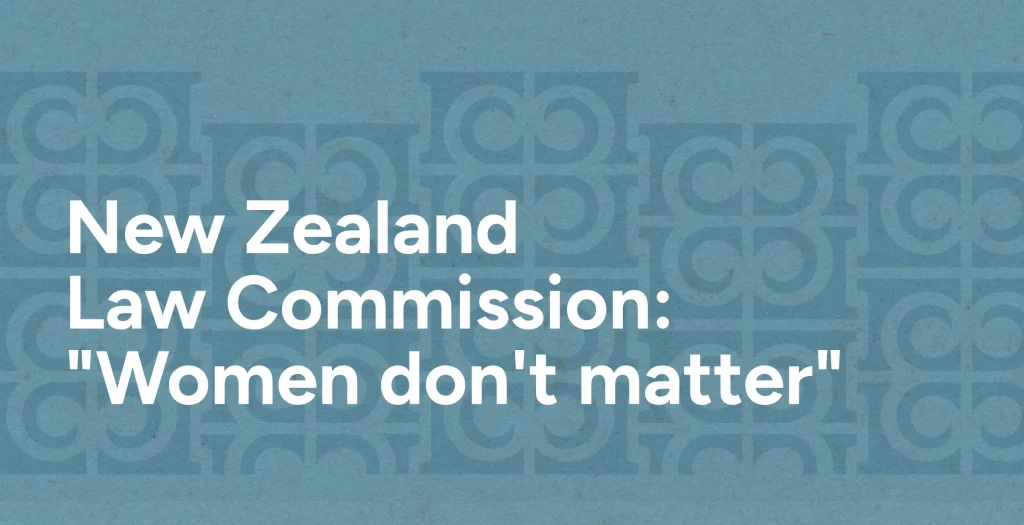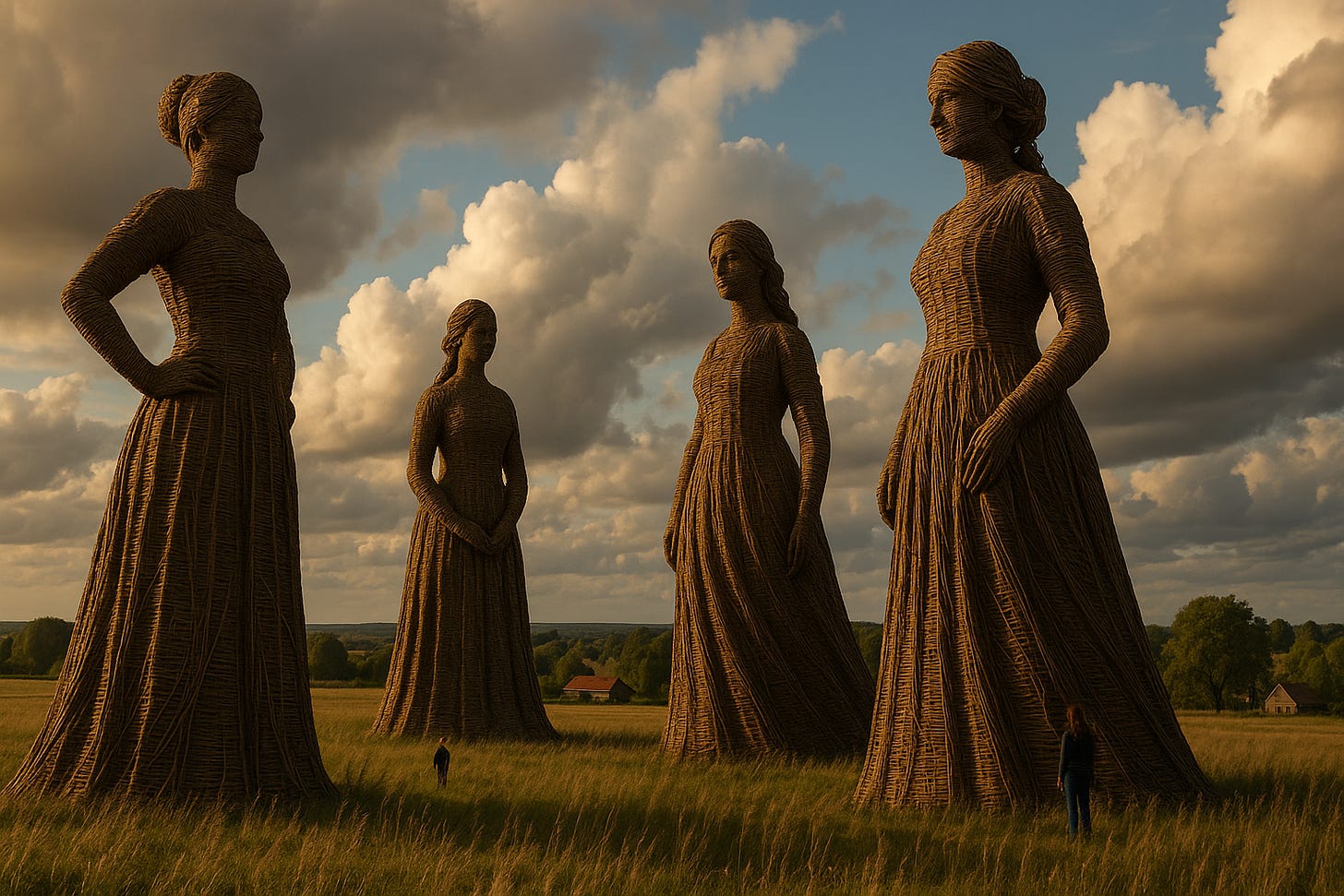A Field of Straw Women Fallacies
Patterns across Four Responses to the Ia Tangata Report
A straw woman or straw man fallacy is a style of bad faith rhetoric where someone fabricates an exaggerated or weaker version of an argument someone made and tries to refute that, rather than engaging with and confronting their actual argument.
The NZ Law Commission recently released Ia Tangata, a review of the Human Rights Act 1993 with respect to people who are transgender, or non-binary for people with innate variations of sex characteristics. The 457-page report is the result of over two years of work and received submissions from a wide range of individuals and groups. The central recommendation is that the Act:
“should be amended to clarify that the Act covers discrimination that is due to a person being transgender or non-binary or having an innate variation of sex characteristics” (NZLC R150, p. 12)
The report and its recommendations have not been well-received in NZ gender critical circles as shown in the following four articles and media statements:
Garwhoungle: It’s out: the Law Commission report
Women’s Rights Party: Sex matters in life, language and law
Speak Up For Women: Law Commission officially untethers from reality
Ani O’Brien: Institutional Insanity: The Law Commission jumps the shark in new report
Rather than engage with the actual report on its own terms, these four pieces dismiss the report, the process, and the people involved, then substitute a simplified, more alarming version of the recommendations that is easier to attack. This is the straw woman in action. It relies on two linked moves that run through the responses: disavowal, which denies or misstates what gender identity is, and fear-mongering, which inflates trans people and routine human rights analysis into sweeping threats. What follows will deconstruct these moves, demonstrating precisely how they replace the Commission's detailed analysis with a simplistic and misleading caricature.
Disavowal
The contemporary understanding of gender identity draws on over 60 years of psychological research and practice and is accepted by the World Health Organization internationally and all major mental health professional organisations in Aotearoa, including counsellors, psychotherapists, psychologists and psychiatrists.
Gender identity is the internal psychological experience of one’s gender. It is a component of self-concept, distinct from sexual orientation, which concerns patterns of attraction, and from gender expression, which is outward presentation and behaviour. Everyone has a gender identity. When it aligns with the sex recorded at birth and with how others perceive you (which is what cisgender means), you may not notice that for others it can be independent.
Naming or disclosing an identity does not create it. Transition does not alter gender identity; it aligns expression and, where appropriate, aspects of the body with that identity to relieve dysphoria and related distress.
Many gender critical women insist they don’t have a gender identity, which is like saying you don’t have a handedness or a sexual orientation. Ironically, the same individuals often put “adult human female” in their bios which is a clear statement of the very sense which they claim they don’t have.
Each of the four pieces follows a consistent pattern of denial, trivialisation or misrepresentation of gender identity:
1. Insisting the concept is undefined, elastic, or unreal
“meaningless definition” (Garwhoungle); “undefined, subjective category” and “so elastic that a person can declare… change the next day” (Ani O’Brien); “untethers from reality” (Speak Up For Women).
This gate keeps at the definition stage so nothing downstream needs to be considered.
2. Rebranding identity as a belief, feeling, or idea
“people who believe in gender identity” (Garwhoungle); “the feelings of some men” (Speak Up For Women); “protecting an idea inside someone’s head” (Ani O’Brien); the report “officially untethers from reality” (Speak Up For Women).
These lines recast a core part of the self as a creed, mood, or unreality so refusal can look like free thought rather than discrimination.
3. Downgrading identity to a casual proclamation
“those who identify as women” (Garwhoungle); “a man who identifies as a woman” (Women’s Rights Party); “any male who proclaims a female inner gender identity” (Speak Up For Women); “anyone who identifies as a woman” and “boys who identify as girls” (Ani O’Brien).
Here “identifies as” is a rhetorical downgrading that recasts an internal identity as a mere announcement, turning disclosure into a proclamation so it can be waved away.
4. Collapsing identity into or against sex
“If ‘sex’ is to be conflated with ‘gender identity’…” (Women’s Rights Party); “Gender identity… rejects biological sex altogether” and creates a “legal fiction” where sex is “what you feel it is” (Ani O’Brien).
This forces a zero-sum frame. Sex and gender identity are distinct constructs. Recognising gender identity does not ‘erase’ sex, and single-sex contexts remain in the recommendations where justified on a case-by-case basis as is common in human rights analysis.
Why this disavowal persists
The established definition of gender identity is widely available and central to the human rights context the report addresses. Yet, the same misrepresentations consistently recur from the above authors. A plausible explanation is shame avoidance: accepting the definition above would force a painful reckoning with exclusionary claims and practices. That threatens a self-image of fairness and reasonableness, so the category is kept unclear.
Within this model, any resulting shame can be disowned and defensively converted into anger directed at the source. This helps explain why the reaction from these authors is not one of reasoned disagreement, but of sheer outrage, with rhetoric that spikes to “hanging women out to dry” (Garwhoungle), “dangerous” (Speak Up For Women), “jumps the shark” (Ani O’Brien), and “couldn’t be worse” (Women’s Rights Party).

Identity-protective cognition keeps the loop going. A sex-only world-view treats a distinct identity construct as a status threat, so the goalposts for definitional adequacy are set impossibly high for gender identity, while the majority’s own identity is treated as neutral common sense. The result is not engagement with the report’s analysis but motivated refusal to see it.
Once identity is minimised or treated as unreal, routine human-rights recommendations can be reframed as sweeping risks.
Fear-mongering
The four responses build their case on a foundation of fear, framing trans women as a danger in public spaces. This requires them to ignore the report's explicit findings on safety. After reviewing the evidence, the Commission stated plainly:
"...we have not found evidence to support the concern that clarifying the legal entitlement of people who are transgender to use a single-sex facility that aligns with their gender identity exacerbates safety risks for cisgender women and girls" (NZLC R150, p. 34).
The Commission's finding is consistent with external research; A 2018 US study of gender identity-inclusive public-accommodation laws likewise found no increase in crimes in restrooms, locker rooms or changing rooms after the law took effect. Despite that, the four responses continue to frame trans women as a danger in public spaces:
“The Law Commission systematically recommends the dismantling of almost all the exceptions that are in place to protect women and girls” (Garwhoungle);
“the Commission is recommending changes to most of the 19 existing exceptions… [including] toilets and changing facilities, women’s refuges and rape crisis centres, and women’s prisons” (Women’s Rights Party);
“Women and girls… should in many instances be compelled to share single sex spaces, sport, schools, and services with any male who proclaims a female inner gender identity… Ridiculously, the onus is on women to prove otherwise” (Speak Up For Women);
“public bathrooms and changing rooms will now be open to anyone who identifies as a woman”, “even private single-sex schools… will have to admit boys who identify as girls”, “a legal crowbar to pry open every women’s space, every sporting category, every workplace policy, and every public debate” (Ani O’Brien)
These claims are blatant straw women. The report does not recommend a “dismantling of almost all the exceptions.” Instead, it describes a measured and targeted process:
“We have taken a case-by-case approach to analysing whether and how each of the sex exceptions in Part 2 of the Human Rights Act should apply to the new grounds we propose” (NZLC R150, p. 22).
The most significant distortion is the idea that vulnerable spaces like women's refuges will have unqualified, "unchecked entry." This is false. For shared accommodation, the report includes a critical safeguard, stating a person can only be excluded if that is:
“...reasonably required to preserve the privacy or to protect the welfare of any occupant or potential occupant of the accommodation” (NZLC R150, p. 43).
This welfare-based test, which leaves discretion to providers, directly refutes the caricature of compulsion.
So contrary to the above claims, the recommendations retain single-sex provision and add that gender identity is not, by itself, a basis to exclude trans women, given the lack of evidence of safety concerns. Cis men may still be excluded. Nothing in the recommendations opens women-only spaces to cis men. This distinction is central, yet the responses collapse it by treating trans women as “any male,” falsely asserting that women’s spaces will be “open to anyone.” They want to insist that facilities managers and sporting administrators should be forced to respect their unjustified prejudices. In place of case-by-case proportionality, they demand blanket exclusions.
It’s clear from the above that gender critical women frequently deploy fear and disgust cues towards trans women, which is literally what defines transphobia. To support their fears, gender critical voices often cite dubiously sourced or misread prison statistics as if they proved trans women, as a group, are a danger to women and girls in public spaces. While a cis woman sex offender such as Lisa Biron is treated as an individual, any trans offenders are taken to stand for all trans women. This is applying negative stereotypes to a whole group of innocent individuals, literally pre-judging them. And that is a textbook example of prejudice.
When pressed for actual evidence regarding public spaces, the claim often shifts to “the police/state is refusing to keep proper statistics”, an argument from conspiracy and paranoid fear itself is offered in place of evidence.
We’ve been here before
There are clear historical rhymes. During the Lavender Menace of the 1970s, lesbians were framed as a threat to straight women and girls in public places. Bathrooms, locker rooms, and women’s organisations were treated as sites of moral danger, and exclusion was sold as protection. Similarly, during the Jim Crow era, toilet and bathroom segregation was justified as protection for white women, with crime and disease stereotypes pushed onto Black women to justify keeping facilities separate. In both cases dread was treated as fact and segregation followed. The structure here is the same: elevate fears, claim needs for safety, and then legislate exclusion.
Human rights law protections on the basis of race and sexual orientation were needed to break the above injustices. Proportionality keeps women-only provision where privacy, safety, dignity, fairness, or programme purpose actually require it, and rejects blanket exclusions that do not. The duty to justify sits with the decision-maker relying on an exception, not with women as a class, and the standard requires legitimate reasons that fit the purpose of the setting.
Fear is not a fact.
Prejudice framed as protection is still just prejudice.
Straw woman fabrications are not a refutation.



Excellent, thank you for this. Trans rights are not radical, they are routine human rights